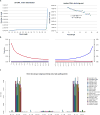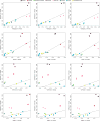The genome of a Late Pleistocene human from a Clovis burial site in western Montana
- PMID: 24522598
- PMCID: PMC4878442
- DOI: 10.1038/nature13025
The genome of a Late Pleistocene human from a Clovis burial site in western Montana
Abstract
Clovis, with its distinctive biface, blade and osseous technologies, is the oldest widespread archaeological complex defined in North America, dating from 11,100 to 10,700 (14)C years before present (bp) (13,000 to 12,600 calendar years bp). Nearly 50 years of archaeological research point to the Clovis complex as having developed south of the North American ice sheets from an ancestral technology. However, both the origins and the genetic legacy of the people who manufactured Clovis tools remain under debate. It is generally believed that these people ultimately derived from Asia and were directly related to contemporary Native Americans. An alternative, Solutrean, hypothesis posits that the Clovis predecessors emigrated from southwestern Europe during the Last Glacial Maximum. Here we report the genome sequence of a male infant (Anzick-1) recovered from the Anzick burial site in western Montana. The human bones date to 10,705 ± 35 (14)C years bp (approximately 12,707-12,556 calendar years bp) and were directly associated with Clovis tools. We sequenced the genome to an average depth of 14.4× and show that the gene flow from the Siberian Upper Palaeolithic Mal'ta population into Native American ancestors is also shared by the Anzick-1 individual and thus happened before 12,600 years bp. We also show that the Anzick-1 individual is more closely related to all indigenous American populations than to any other group. Our data are compatible with the hypothesis that Anzick-1 belonged to a population directly ancestral to many contemporary Native Americans. Finally, we find evidence of a deep divergence in Native American populations that predates the Anzick-1 individual.
Conflict of interest statement
The authors declare no competing financial interests.
Figures










Comment in
-
Palaeogenomics: genetic roots of the first Americans.Nature. 2014 Feb 13;506(7487):162-3. doi: 10.1038/506162a. Nature. 2014. PMID: 24522593 No abstract available.
References
-
- Waters MR, Stafford TW. Redefining the age of Clovis: implications for the peopling of the Americas. Science. 2007;315:1122–1126. - PubMed
-
- Goebel T, Waters MR, O’Rourke DH. The late Pleistocene dispersal of modern humans in the Americas. Science. 2008;319:1497–1502. - PubMed
-
- Meltzer DJ. First Peoples in a New World. Univ of California Press; 2009.
-
- Stanford DJ, Bradley BA. Across Atlantic Ice: The Origin of America’s Clovis Culture. University of California Press; 2012.
Publication types
MeSH terms
Substances
Associated data
- Actions
- Actions
- Actions
- SRA/SRX381032
Grants and funding
LinkOut - more resources
Full Text Sources
Other Literature Sources
Research Materials

